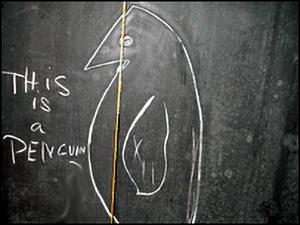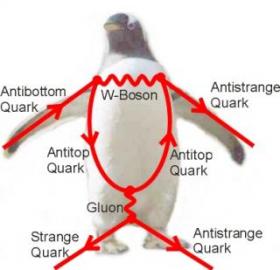Penguins

Penguins (order Sphenisciformes, family Spheniscidae) are a group of aquatic, flightless birds living almost exclusively in the southern hemisphere, especially in Antarctica. Highly adapted for life in the water, penguins have countershaded dark and white plumage, and their wings have become flippers. Most penguins feed on krill, fish, squid, and other forms of sealife caught while swimming underwater. They spend about half of their life on land and half in the oceans.
Among extant penguins, larger penguins inhabit colder regions, while smaller penguins are generally found in temperate or even tropical climates (see also Bergmann's Rule). Some prehistoric species attained enormous sizes, becoming as tall or as heavy as an adult human.
These were not restricted to Antarctic regions; on the contrary, subantarctic regions harbored high diversity, and at least one giant penguin occurred in a region not quite 2,000 km south of the equator 35 mya, in a climate decidedly warmer than today.
There are 17 to 19 known species worldwide, depending on whether the two Eudyptula species are counted as distinct. Although all penguin species are native to the southern hemisphere, they are not, contrary to popular belief, found only in cold climates, such as Antarctica. In fact, only a few species of penguin actually live so far south. Three species live in the tropics; one lives as far north as the Galpagos Islands (the Galapagos Penguin) and will occasionally cross the equator while feeding.
The largest species is the Emperor Penguin (Aptenodytes forsteri): adults average about 1.1 meters (3 ft 7 in) tall and weigh 35 kilograms (75 lb) or more. The smallest penguin species is the Little Blue Penguin (also known as the Fairy Penguin), which stands around 40 cm tall (16 in) and weighs 1 kilogram (2.2 lb). Generally larger penguins retain heat better, and thus inhabit colder regions, while smaller penguins are found in temperate or even tropical climates.
The rarest type of penguin is the yellow-eyed penguin (Megadyptes antipodes) and is probably the most ancient of all living penguins: adults average about 65 cm tall and weigh 5-6 kilograms.
Most penguins feed on krill, fish, squid, and other forms of sealife caught while swimming underwater. They spend half of their life on land and half in the oceans.
One of the most baffling forms of behavior of the penguin comes when a mother loses her chick, either due to its being unable to endure its first storm, or due to other reasons such as predators. When a mother loses its chick, they have been known to actually attempt to steal another mother's living chick- presumably in order to deal with the grief of the loss.
This behavior has amazed scientists, as it is an emotional outburst opposed to an instinctual behavior; something many wild animals do not exhibit when losing their young. Many have used this as prime evidence for decades that many animals have near human-like emotions and feelings, often for the sake of animal rights. Naturally, the other females in the penguin groups dislike this behavior and will help the defending mother keep her chick.
This behavior, however, might be better explained as a means for the female, or the male, to retain the full cooperation of the other parent in rearing the young, given that the bonding is monogamous; most likely there are differences between males and females in regards to the likelihood of chick-robbing and between species in relation to whether the monogamy is seasonal or permanent. Penguins seem to have no fear of humans, and have approached groups of explorers without hesitation.
The evolutionary history of penguins is poorly understood, as penguin fossils are rare. The oldest known fossil penguin species are the Waimanu, which lived in the early Paleocene epoch of New Zealand, about 62 million years ago. While they were not as well adapted to aquatic life as modern penguins (which first emerged in the Eocene epoch 40 million years ago), Waimanu were flightless and loon-like, with short wings adapted for deep diving.
These fossils prove that prehistoric penguins were already flightless and seagoing, so their origins probably reach as far back as 65 million years ago, before the extinction of the dinosaurs. Penguin ancestry beyond Waimanu is not well known, though some scientists (Mayr, 2005) think the penguin-like plotopterids (usually considered relatives of anhingas and cormorants) may actually be an early sister group of the penguins, and that penguins may have ultimately shared a common ancestor with the Pelecaniformes.
Anatomy
Penguins are superbly adapted to an aquatic life. Their wings have become flippers, useless for flight in the air. In the water, however, penguins are astonishingly agile. Within the smooth plumage a layer of air is preserved, ensuring buoyancy. The air layer also helps insulate the birds in cold waters. The plumage of penguins in tropical and temperate zones is much thinner than that of more southern species.
On land, penguins use their tails and wings to maintain balance for their upright stance.All penguins have a white underside and a dark (mostly black) upperside. This is for camouflage. A predator looking up from below (such as an orca or a leopard seal) has difficulty distinguishing between a white penguin belly and the reflective water surface. The dark plumage on their backs camouflages them from above.
Diving penguins reach 6 to 12 km/h, though there are reports of velocities of 27 km/h (which are probably realistic in the case of startled flight). The small penguins do not usually dive deep; they catch their prey near the surface in dives that normally last only one or two minutes.
Larger penguins can dive deep in case of need. Dives of the large Emperor Penguin have been recorded which reach a depth of 565 m (1870 ft) and last up to 20 minutes.
Penguins either waddle on their feet or slide on their bellies across the snow, a movement called "tobogganing", which allows them to conserve energy and move relatively fast at the same time.Penguins have an excellent sense of hearing.
Their eyes are adapted for underwater vision, and are their primary means of locating prey and avoiding predators; in air, conversely, they are nearsighted. Their sense of smell has not been researched so far.
They are able to drink salt water safely because their supraorbital gland filters excess salt from the bloodstream. The salt is excreted in a concentrated fluid from the nasal passages.
Penguins have no external genitalia. Consequently, chromosome testing must be done in order to determine a penguin's sex.
Some penguins mate for life, while others for just one season. They generally raise a small brood, and the parents cooperate in caring for the clutch and for the young.
How Penguins Got Their Cold-Weather Coats Live Science - December 21, 2010
Those tuxedo-wearing birds that inhabit Earth's coldest continent may have evolved a means of retaining heat when they were still living in warm climates, scientists now suggest. A key adaptation that helped modern penguins to invade the cold waters of Antarctica within the last 16 million years is the so-called humeral arterial plexus, a network of blood vessels that limits heat loss through the wings.
Ancient giant penguin unearthed in Peru BBC - October 1, 2010

The fossil of a giant penguin that lived 36 million years ago has been discovered in Peru. Scientists say the find shows that key features of the plumage were present quite early on in penguin evolution. The animal's feathers were brown and grey, distinct from the black "tuxedo" look of modern penguins.
Penguins (Cutely) Count Selves National Geographic - February 27, 2009
Penguins Marching Into Trouble Science Daily - February 13, 2009
The penguins' survival is being challenged by wide variability in conditions and food availability, said Dee Boersma, a University of Washington biology professor and a leading authority on Magellanic penguins.
Emperor penguins face extinction BBC - January 27, 2009
Emperor penguins, whose long treks across Antarctic ice to mate have been immortalised by Hollywood, are heading towards extinction, scientists say. Based on predictions of sea ice extent from climate change models, the penguins are likely to see their numbers plummet by 95% by 2100. That level of decline could wreak havoc on the delicate Antarctic food chain. The research is published in the journal Proceedings of the National Academy of Sciences. Emperor penguins, the largest species, are unique in that they are the only penguins that breed during the harsh Antarctic winters.
Secret to Penguin Locomotion Revealed Live Science - November 13, 2008
Penguins are wobbly on land, but their extreme underwater agility involves the perfection of a twisting wing motion that is just now coming to be understood. A new study found that by twisting their wings while pumping them under water to swim, the birds are able to vary the thrust of their flapping and increase control over their movements. The motion is so useful researchers are testing it out on prototypes for new underwater spy vehicles.
Historic penguin sketches found - chalk drawings BBC - December 21, 2007

Penguins Safely Lower Oxygen to "Blackout" Levels National Geographic - December 8, 2007

Giant Penguins Once Roamed Peru Desert, Fossils Show National Geographic - June 25, 2007

Giant Prehistoric Penguins Found National Geographic - June 25, 2007

Confused penguin strays 5,000km BBC - May 11, 2007

A Magellanic penguin whose natural habitat is the cool climes of southern Chile has strayed thousands of miles from his home, arriving in Peru. The penguin, native to the Strait of Magellan region of Chile, swam all the way to Peru's Paracas national reserve. Scientists say the bird appeared to have made the 5,000km (3,000-mile) journey alone. They say the penguin must have "got off course" to end up just 14 degrees south of the equator.
Particle decay may point to New Physics PhysOrg - October 11, 2006

A tiny flaw has caught the attention of physicists: the Standard Model (SM) predicts that the B meson mixing phase should be measured at nearly the same result using two different classes of decay modes. However, observations of the two different decay modes recently gave very different values, resulting in an unexpectedly large discrepancy in the B mixing phase
No comments:
Post a Comment